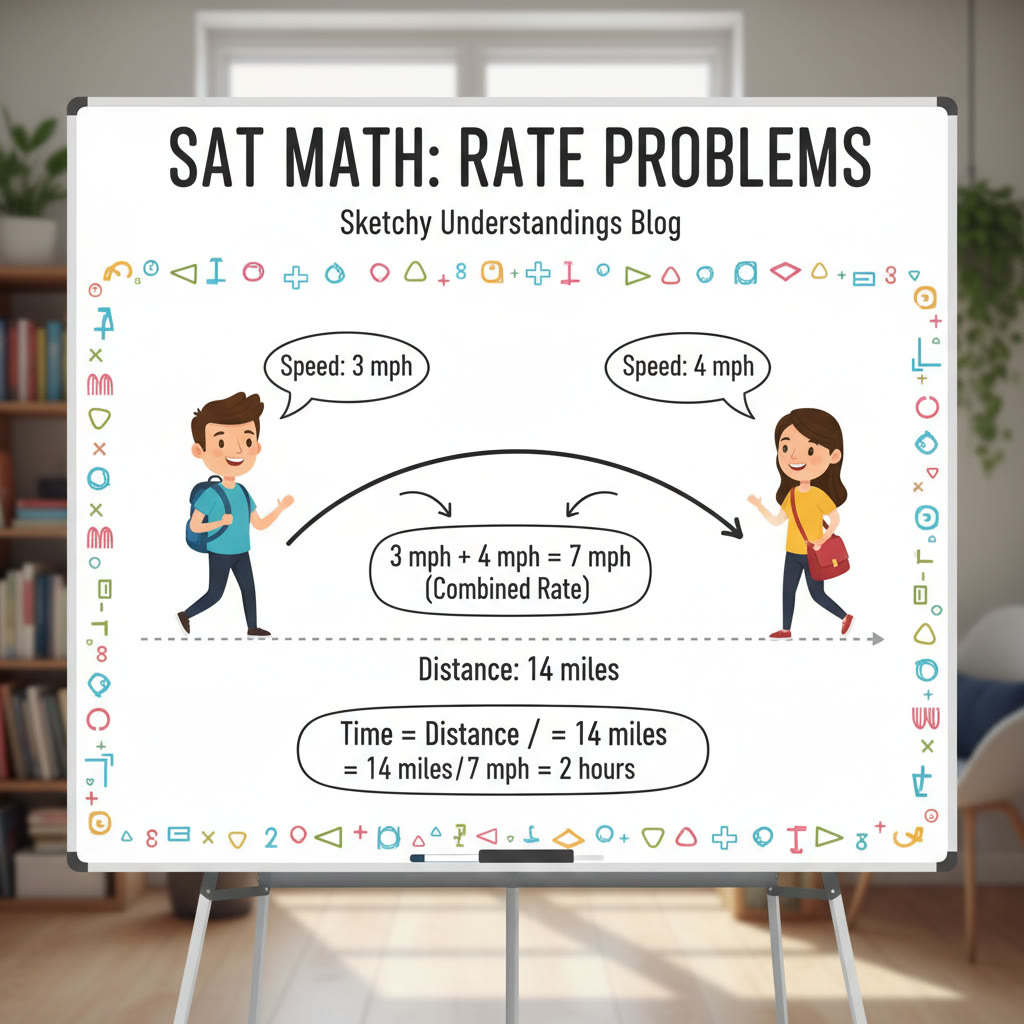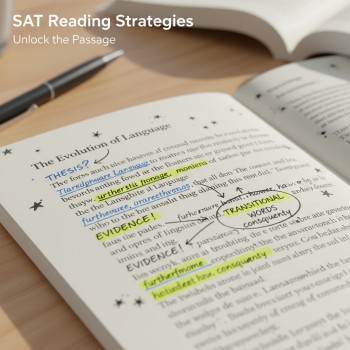The Student’s Guide to SAT Math Word Problems
If you ever stare at a paragraph on the SAT math section and think, Where do I even start?, you are not alone. Word problems are the place where reading, reasoning, and arithmetic meet, and the students who do best are usually the ones who slow down long enough to translate words into math. This guide is written for you: busy, hopeful, and ready to turn confusing scenarios into neat equations you can solve under time pressure.
Why word problems feel so hard
Word problems test more than calculations. They test:
- Reading comprehension: understanding exactly what the problem asks.
- Translation skills: turning words into mathematical relationships.
- Strategy: deciding whether to use algebra, diagrams, or logical elimination.
- Careful work: avoiding small errors that blow up later.
On the SAT, problems are designed to reward thinking over mechanical work. If you learn a repeatable approach, you will make fewer careless errors and finish more comfortably.
A simple four-step framework
Use this framework as your baseline. It works for most SAT word problems.
- Step 1: Read actively. Circle numbers and underline what is being asked.
- Step 2: Define variables and write a translation. Choose one variable when possible.
- Step 3: Solve. Build an equation or draw a diagram, then calculate.
- Step 4: Check. Substitute your answer back, check units, and estimate to see if it makes sense.
Letâs unpack each step with tips and examples.
Step 1: Read actively
Active reading means you don’t passively scan the sentence. Mark it up. Put a box around important numbers. Put a question mark by the target. This visual scaffolding prevents misreading under time pressure.
- Watch for words that change meaning: total vs difference, per vs in total, each vs combined.
- Be careful with units: hours, miles, percent. Convert if necessary so every term in your equation uses the same unit.
- Look for extraneous details. SAT writers sometimes add fluff. Your job is to find what’s relevant.
Step 2: Define variables and translate
Pick a variable and stick to it. If the problem involves more than one unknown, define variables clearly and relate them with equations. Use simple letters: x and y or m for miles, t for time. Poor variable choice is often where students get tangled.
Example translation tip: If the sentence says “three fewer than twice a number,” translate it as: 2x – 3. If it says “three less than twice a number,” it may mean 3 – 2x. Pay attention to phrase order.
Step 3: Solve
Write the equation, then solve. If algebra looks messy, consider alternate strategies the SAT favors: plugging in numbers, working backward from answer choices, or using diagrams. All are legitimate — pick the one that saves time and reduces errors.
Step 4: Check
Answer checking is non-negotiable. On a timed test, a quick sanity check can save points. Substitute your solution into the original sentence and see if it fits. If the units don’t match or the number seems absurd, rework the step where the error likely happened.
Common SAT word problem types and smart approaches
Below are the frequent flavors of word problems you’ll meet on the SAT and specific tips for each.
1. Ratios and proportions
These problems often disguise themselves with recipes, mixtures, or scale drawings.
- Tip: When you see the word “per” or a phrase like “for every,” think ratio.
- Trick: Keep parts consistent. If a problem gives ratios and a total, set up fractions with the same denominator for each part.
Example
There are marbles in a bag in the ratio red:blue = 3:5. If there are 32 marbles total, how many are blue? Translate: 3 + 5 = 8 parts; each part is 32/8 = 4; blue = 5 parts = 20.
2. Rates (distance, speed, work)
Rates show up as speed (miles per hour), work (job per hour), or flow (gallons per minute). A key principle: combine rates carefully and ensure the same unit for time.
- Tip for distance: distance = rate x time. If two objects move toward each other, add their rates.
- Tip for work: think of 1/full job as the unit. If A does 1/4 job per hour and B does 1/6, together they do 1/4 + 1/6 = 5/12 job per hour.
Example
Sam cycles at 12 miles per hour and Jess at 8 miles per hour toward each other from points 50 miles apart. How long until they meet? Their combined speed is 20 mph, so time = distance/speed = 50/20 = 2.5 hours.
3. Percent problems
Not every percent question wants you to do messy decimal work. Translate to fractions where possible and watch for changes relative to base values.
- Tip: If a quantity increases by 20% and then decreases by 20%, it does not return to the original; calculate sequentially, not by net percent.
Example
An item priced at $100 is discounted by 20% and then increased by 20%. After the discount it costs $80; increasing $80 by 20% gives $96, not $100.
4. Mixture problems
Treat concentrations as weighted averages. A simple way is to use total amount times percent equals amount of the substance.
Example
Mix 10 liters of a 30% solution with x liters of a 60% solution to get a 45% solution. Equation: 10(0.30) + x(0.60) = (10 + x)(0.45). Solve: 3 + 0.6x = 4.5 + 0.45x, 0.15x = 1.5, x = 10 liters.
5. Geometry word problems
Word-based geometry asks you to visualize. Draw neat diagrams, label everything, and mark right angles or parallel lines. Use formulas from your memory table and check units.
- Tip: Always consider whether the figure is to scale on the page. Donât rely only on the drawing.
- Tip: For area and volume, ensure you square/cube units correctly.
Worked examples: step-by-step
Worked examples help build pattern recognition. Below are several problems with clear translations and checks.
Example 1: Age problem (linear relationships)
Problem: Claire is 4 years older than twice Ben’s age. In 5 years Claire will be three times as old as Ben will be then. How old is Ben now?
Step 1: Define variable. Let Ben’s current age be x.
Step 2: Translate. Claire = 2x + 4. In 5 years: Claire = 2x + 4 + 5, Ben = x + 5. Equation: 2x + 9 = 3(x + 5).
Step 3: Solve. 2x + 9 = 3x + 15, so x = -6. This is impossible for an age, so check algebra. Oops: re-evaluate the translation.
Correct translation: Claire now is 2x + 4. In 5 years, Claire will be (2x + 4) + 5 = 2x + 9, Ben will be x + 5. The equation 2x + 9 = 3(x + 5) is correct. Solving gives 2x + 9 = 3x + 15, subtract 2x and 15: 9 – 15 = x, so x = -6.
What went wrong? The issue is the problem as stated has no realistic solution if interpreted this way, so on the SAT look for minor wording differences. In a typical test, numbers are chosen so x is positive. Always verify the original text and ensure you copied numbers correctly. This example teaches a subtle lesson: when algebra yields impossible results, re-check transcription and meaning.
Example 2: Work problem
Problem: Machine A fills a container in 3 hours, Machine B fills it in 6 hours. Working together, how long to fill one container?
Translation: A’s rate = 1/3 container/hour, B’s = 1/6. Combined rate = 1/3 + 1/6 = 1/2 container/hour. Time = 1 / (1/2) = 2 hours.
Check: In 2 hours A fills 2/3, B fills 1/3, total 1 container. Good.
Example 3: Geometry and algebra
Problem: A rectangle’s length is 3 meters longer than its width. Area is 40 square meters. Find the width.
Let width = w, length = w + 3. Equation: w(w + 3) = 40 => w^2 + 3w – 40 = 0.
Factor: (w + 8)(w – 5) = 0, so w = 5 (reject negative). Width is 5 meters.
Check: Length = 8, area = 5*8 = 40. Good.
Practice strategies and timing
Time on the SAT is limited. Word problems often take longer than single-step arithmetic, so manage time with these strategies.
- Do the low-hanging fruit first. If a word problem looks long and messy, skip and return if time allows.
- Use the answer choices when stuck. Plug options into the situation to find which works.
- Plugging in numbers works well for algebraic expressions. Choose a convenient number, replace variables, solve numerically, then map back.
- Estimate to eliminate implausible choices. If your rough estimate is 75, you can likely eliminate choices near 10 or 1,000.
Daily practice plan
Consistency beats intensity. Try this six-week cycle close to your test date.
- Weeks 1-2: Focus on fundamentals. Do 10-15 word problems daily, covering different types. Review errors carefully.
- Weeks 3-4: Time trials. Do mixed sections under timed conditions. Start learning when to skip and when to dig in.
- Weeks 5-6: Full practice tests and targeted drills. Identify weakest problem types and concentrate practice there.
If you prefer personalized pacing and feedback, Sparklâs personalized tutoring offers 1-on-1 guidance, tailored study plans, and expert tutors who can pinpoint the exact problem types to focus on. Their AI-driven insights can highlight patterns in your errors so every practice minute is efficient.
Common traps and how to avoid them
- Mistaking “per” for addition: If a question says 5 dollars per book, and you buy 3 books, the cost is 5 x 3, not 5 + 3.
- Mixing units: hours and minutes, miles and kilometers. Convert before summing or comparing.
- Forgetting parentheses: when translating phrases like “twice the sum of x and 3,” write 2(x + 3).
- Answer choice temptation: The SAT sometimes includes tempting decoys that look right until you do a final check. Always plug back if unsure.
Quick reference table: common translations and formulas
| Phrase | Translation |
|---|---|
| Twice a number | 2x |
| Three fewer than twice a number | 2x – 3 |
| Each, per | Division or multiplication depending on context (e.g., miles per hour = miles / hours) |
| Work rate | Fraction of job per hour, e.g., 1/4 means one quarter of job per hour |
| Area rectangle | length x width |
| Area circle | pi x radius squared |
When to use alternate strategies
Some problems are fast with algebra, some are faster with plugging in, and some reward a neat diagram. Here are guidelines:
- Plug in numbers when variables appear messily and the answer choices are numbers. Choose simple, convenient values that don’t break the problem conditions.
- Work backward when answer choices are limited and the problem asks for a final value after several operations.
- Draw a picture when geometry or relative positioning is involved. A good diagram often cuts complexity in half.
How to turn practice into lasting improvement
Practice isn’t just doing problems; it’s deliberate practice. That means:
- Analyze each error. Donât move on until you can explain why the mistake happened and how to avoid it.
- Keep an error log. Track common mistakes by problem type and review weekly.
- Mix problem types. Real tests present varied questions, so practice with mixed sets to build flexible thinking.
Pairing these habits with targeted help can accelerate progress. If you want a personalized study plan and one-on-one guidance, Sparklâs tutors offer tailored study plans and immediate feedback, helping you close gaps efficiently.
Final checklist to use on test day
- Read every word problem twice: once to get the scenario, once to translate carefully.
- Write units down immediately and track them through calculations.
- Estimate before you compute to catch impossible answers early.
- Use the answer choices to check your work when appropriate.
- Flag and skip overly long word problems on your first pass to manage time.


Parting advice
Word problems are less about memorizing tricks and more about learning to think clearly. The SAT rewards a calm, methodical approach: read carefully, translate precisely, pick the best solving method, and always check. With consistent practice, mistakes will shrink and your confidence will grow.
Remember, improvement happens in small, steady steps. Start each study session with a short warm-up of 5 mixed word problems, then target your weakest area for focused work. Track your progress, celebrate small wins, and donât be afraid to ask for help when a topic keeps tripping you up. Personalized tutoring, like the 1-on-1 guidance Sparkl provides, can speed up progress by creating a study plan built around your particular stumbling blocks and leveraging AI-driven insights to identify patterns in your errors.
Youâre already on the right track by learning strategies. Keep practicing, stay curious, and treat every problem as a little puzzle that teaches you one more way to win on test day. Good luck â youâve got this.




















No Comments
Leave a comment Cancel